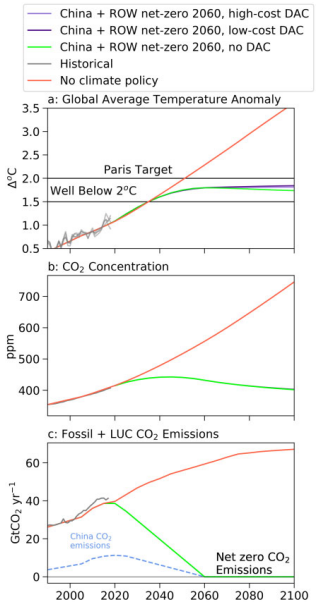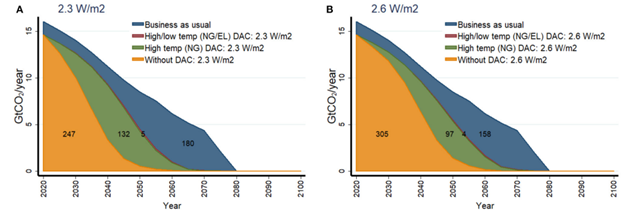Meeting China’s 2060 Carbon Neutrality Goal
This paper models the use of direct air capture and other negative transmission technologies (NETs) in China to understand the role of NETs in helping China and the international community achieve carbon neutrality by 2060.
The recent pledge from China to achieve carbon neutrality by 2060 provides a major contribution toward limiting climate change to below +2°C above preindustrial levels, but greater near-term emissions cuts and/or long-term future net-negative emissions are required to meet the goal. This paper models these different futures to understand the role of negative emissions technologies in helping to achieve the net-zero by 2060 target.

Though more expensive than other decarbonization methods, NETs are being developed to offset stubborn emissions from transportation and manufacturing and potentially reduce future atmospheric CO2 levels. The authors analyzed China’s options to achieve net-zero CO2 emissions using the Global Change Analysis Model (GCAM) with the following three major sources of negative emissions: bioenergy with carbon capture and storage (BECCS), afforestation, and direct air capture (DAC) with carbon storage.
The models show that DAC can play a large role in helping China achieve its net-zero emissions target and reduce global emissions. The extent to which DAC is deployed depends on its cost, which is expected to decrease over time as technologies improve with widespread implementation. Without DAC, China could reach net-zero CO2 emissions by 2060, but this would need to come from BECCS and afforestation at an increasingly higher marginal cost than if DAC could be used alongside them. With DAC widely available, China’s could reduce its emissions by 2–3 billion tons of carbon dioxide (GtCO2) per year, though DAC at this scale would require a substantial increase in investment.
Using DAC instead of solely relying on BECCS and afforestation would also free up more land for agricultural production and reduce the use of water for bioenergy crops, though DAC also requires large quantities of water. In addition to improvements that reduce the financial and natural resource intensity of DAC and other NETs, greater investment in technologies to avoid emissions, such as transportation and industrial electrification, could also reduce the land and water tradeoffs of negative emissions with DAC.

For the full study, download the file below.


